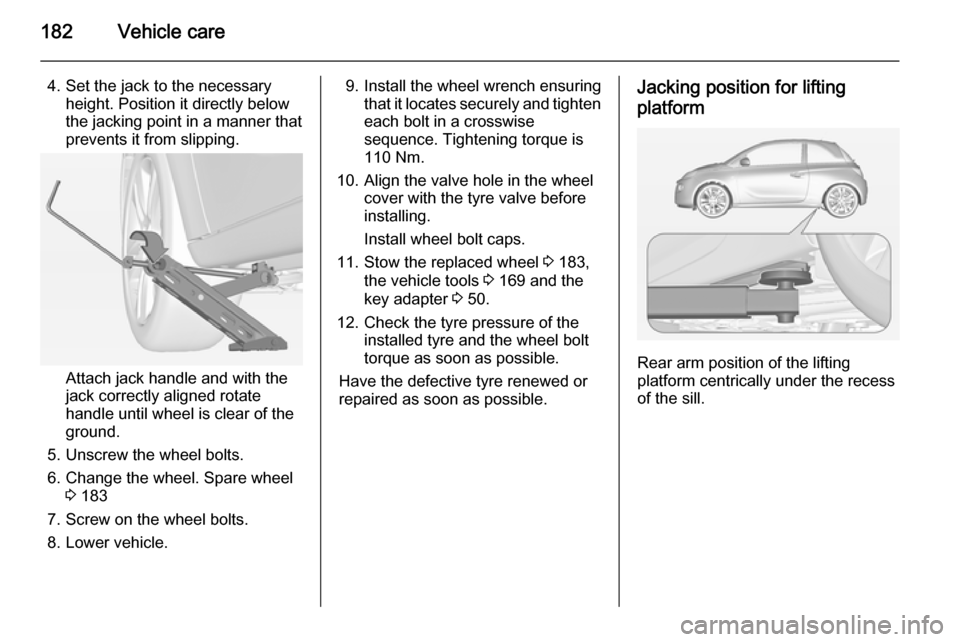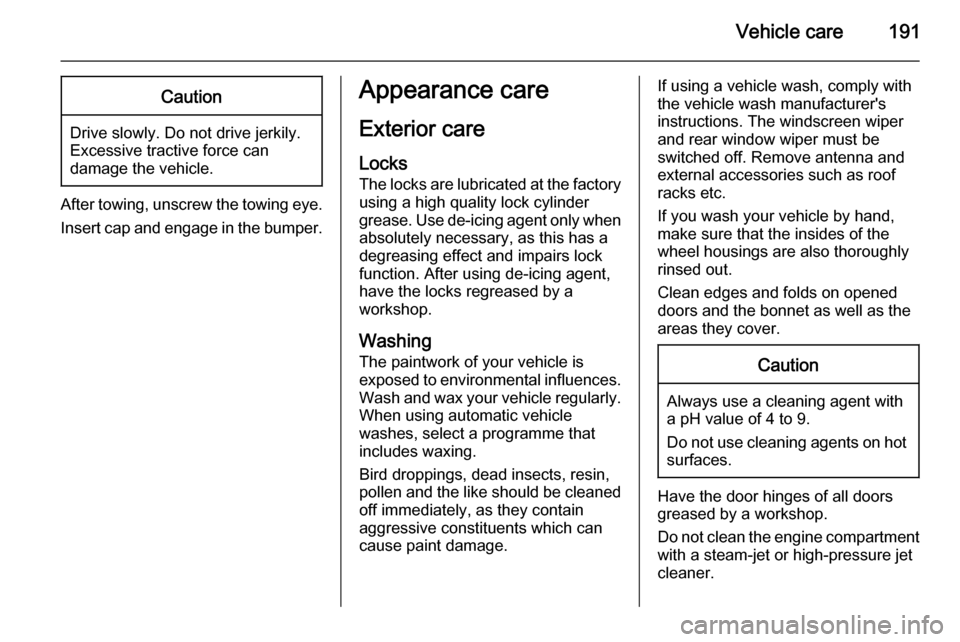tow VAUXHALL ADAM 2014.5 Owner's Guide
[x] Cancel search | Manufacturer: VAUXHALL, Model Year: 2014.5, Model line: ADAM, Model: VAUXHALL ADAM 2014.5Pages: 217, PDF Size: 6.68 MB
Page 181 of 217

Vehicle care179
12. All of the sealant is pumped intothe tyre. Then the tyre is inflated.
13. The prescribed tyre pressure should be obtained within
10 minutes. Tyre pressure
3 207 . When the correct pressure
is obtained, switch off the
compressor.
If the prescribed tyre pressure is
not obtained within 10 minutes,
remove the tyre repair kit. Move
the vehicle one tyre rotation.
Reattach the tyre repair kit and
continue the filling procedure for
10 minutes. If the prescribed tyre
pressure is still not obtained, the
tyre is too badly damaged. Seek
the assistance of a workshop.
Drain excess tyre pressure with
the button over the pressure indicator.
Do not run the compressor longer
than 10 minutes.
14. Detach the tyre repair kit. Push catch on bracket to remove
sealant bottle from bracket. Screw the tyre inflation hose to the freeconnection of the sealant bottle.
This prevents sealant from
escaping. Stow tyre repair kit in
load compartment.
15. Remove any excess sealant using a cloth.
16. Take the label indicating maximum permitted speed from
the sealant bottle and affix in the
driver's field of view.
17. Continue driving immediately so that sealant is evenly distributedin the tyre. After driving approx.
6 miles (but no more than
10 minutes), stop and check tyre
pressure. Screw compressor airhose directly onto tyre valve and
compressor when doing this.
If tyre pressure is more than
1.3 bar , set it to the correct value.
Repeat the procedure until there
is no more loss of pressure.
If the tyre pressure has fallen
below 1.3 bar, the vehicle must
not be used. Seek the assistance
of a workshop.
18. Stow away tyre repair kit in load compartment. On version with
subwoofer install floor cover. Rear
floor storage cover 3 64.
Page 184 of 217

182Vehicle care
4. Set the jack to the necessaryheight. Position it directly below
the jacking point in a manner that
prevents it from slipping.
Attach jack handle and with the
jack correctly aligned rotate handle until wheel is clear of theground.
5. Unscrew the wheel bolts.
6. Change the wheel. Spare wheel 3 183
7. Screw on the wheel bolts.
8. Lower vehicle.
9. Install the wheel wrench ensuring that it locates securely and tighten
each bolt in a crosswise
sequence. Tightening torque is
110 Nm.
10. Align the valve hole in the wheel cover with the tyre valve before
installing.
Install wheel bolt caps.
11. Stow the replaced wheel 3 183,
the vehicle tools 3 169 and the
key adapter 3 50.
12. Check the tyre pressure of the installed tyre and the wheel bolttorque as soon as possible.
Have the defective tyre renewed or
repaired as soon as possible.Jacking position for lifting
platform
Rear arm position of the lifting
platform centrically under the recess
of the sill.
Page 186 of 217

184Vehicle care
4.Lift the spare wheel holder a bit by
hand and unhook the catch.
5. Lower the spare wheel holder.
6. Lift the spare wheel holder a bit by
hand and detach the safety cable.
7. Lower holder all the way and remove spare wheel.
8. Change the wheel 3 180.
The damaged wheel has to be
secured in the load compartment,
see below.
9. Lift the empty spare wheel holder and insert the safety cable.
10. Lift the spare wheel holder farther
and engage in catch. The open
side of the catch must point in the
direction of travel.
11. Close the empty spare wheel holder by turning the hexagon boltclockwise successively using the
wheel wrench.
12. Stow wheel wrench and the jack in the tool box in vehicle floor.
13. Close the load compartment floor.
Stowing a damaged wheel in the
load compartment The spare wheel holder is not
designed for other tyre sizes than the
spare wheel.
A damaged wheel wider than the
spare wheel has to be stowed in the
load compartment and secured with a strap. Vehicle tools 3 169.Wheels with tyre size up to
195/55R16 1. Remove load compartment cover and lift up load compartment floor.
Stow both behind the raised up
backrests of the rear seats.
Page 189 of 217

Vehicle care1879Warning
Storing a jack, a wheel or other
equipment in the load
compartment could cause injury if they are not fixed properly. During a sudden stop or a collision, looseequipment could strike someone.
Store jack and tools always in the
respective storage compartments
and secure them by fixing.
Damaged wheel placed in the load
compartment must always be
secured by the strap.
Temporary spare wheel
The use of the temporary spare wheel
could affect driveability. Have the
defective tyre renewed or repaired as soon as possible.
Only mount one temporary spare
wheel. Do not drive faster than
50 mph. Take curves slowly. Do not
use for a long period of time.
If your vehicle gets a flat tyre on the
rear while towing another vehicle,
mount the temporary spare wheel in the front and the full size tyre in the
rear.
Tyre chains 3 176.
Directional tyres
Fit directional tyres such that they roll in the direction of travel. The rolling
direction is indicated by a symbol
(e.g. an arrow) on the sidewall.
The following applies to tyres fitted
opposing the rolling direction:
■ Driveability may be affected. Have the defective tyre renewed or
repaired as soon as possible.
■ Drive particularly carefully on wet and snow-covered road surfaces.Jump starting
Do not start with a quick charger.
A vehicle with a discharged vehicle
battery can be started using jump
leads and the vehicle battery of
another vehicle.9 Warning
Be extremely careful when starting
with jump leads. Any deviation
from the following instructions can
lead to injuries or damage caused
by battery explosion or damage to the electrical systems of both
vehicles.
9 Warning
Avoid contact of the battery with
eyes, skin, fabrics and painted
surfaces. The fluid contains
sulphuric acid which can cause
injuries and damage in the event
of direct contact.
Page 191 of 217

Vehicle care189
4. Switch on electrical consumers(e.g. headlights, heated rear
window) of the vehicle receiving
the jump start.
5. Reverse above sequence exactly when removing leads.Towing
Towing the vehicle
Disengage the cap by pushing on the
marked position.
The towing eye is stowed with the
vehicle tools 3 169.
Screw in the towing eye as far as it will
go until it stops in a horizontal
position.
Attach a tow rope – or better still a tow
rod – to the towing eye.
The towing eye must only be used for
towing and not for recovering the
vehicle.
Switch on ignition to release steering wheel lock and to permit operation of
brake lights, horn and windscreen
wiper.
Transmission in neutral.
Page 192 of 217

190Vehicle careCaution
Drive slowly. Do not drive jerkily.
Excessive tractive force can
damage the vehicle.
When the engine is not running,
considerably more force is needed to
brake and steer.
To prevent the entry of exhaust gases from the towing vehicle, switch on the
air recirculation and close the
windows.
Seek the assistance of a workshop.
After towing, unscrew the towing eye.
Insert cap and engage in the bumper.
Towing another vehicle
Insert a screwdriver in the slot at the
lower bend of the cap. Disengage the cap by carefully moving the
screwdriver downwards.
The towing eye is stowed with the
vehicle tools 3 169.
Screw in the towing eye as far as it will
go until it stops in a horizontal
position.
The lashing eye at the rear
underneath the vehicle must never be used as a towing eye.
Attach a tow rope – or even better a
tow bar – to the towing eye.
The towing eye must only be used for
towing and not for recovering a
vehicle.
Page 193 of 217

Vehicle care191Caution
Drive slowly. Do not drive jerkily.
Excessive tractive force can
damage the vehicle.
After towing, unscrew the towing eye.
Insert cap and engage in the bumper.
Appearance care
Exterior care Locks
The locks are lubricated at the factory using a high quality lock cylinder
grease. Use de-icing agent only when absolutely necessary, as this has a
degreasing effect and impairs lock
function. After using de-icing agent,
have the locks regreased by a
workshop.
Washing The paintwork of your vehicle is
exposed to environmental influences.
Wash and wax your vehicle regularly.
When using automatic vehicle
washes, select a programme that
includes waxing.
Bird droppings, dead insects, resin,
pollen and the like should be cleaned
off immediately, as they contain
aggressive constituents which can
cause paint damage.If using a vehicle wash, comply with
the vehicle wash manufacturer's instructions. The windscreen wiperand rear window wiper must be
switched off. Remove antenna and
external accessories such as roof
racks etc.
If you wash your vehicle by hand,
make sure that the insides of the
wheel housings are also thoroughly
rinsed out.
Clean edges and folds on opened
doors and the bonnet as well as the
areas they cover.Caution
Always use a cleaning agent with
a pH value of 4 to 9.
Do not use cleaning agents on hot surfaces.
Have the door hinges of all doors
greased by a workshop.
Do not clean the engine compartment with a steam-jet or high-pressure jet
cleaner.
Page 215 of 217

213
Service ....................................... 118
Service display ............................ 79
Service information ....................194
Service vehicle soon .................... 84
Side airbag system ......................40
Side blind spot alert ....................143
Sidelights .................................... 102
Side turn signal lights ................163
Spare wheel ............................... 183
Speed limiter............................... 131
Speedometer ............................... 77
Starting and operating ................119
Starting off ................................... 16
Starting the engine ....................120
Steering wheel adjustment ......9, 69
Steering wheel controls ...............69
Stop-start system........................ 121
Storage ......................................... 50
Storage compartments .................50
Sun visors .................................... 29
Symbols ......................................... 4
T Tachometer ................................. 77
Tail lights ................................... 160
Three-point seat belt .................... 35
Tools .......................................... 169
Top-tether fastening eyes ............49
Towing ........................................ 189
Towing another vehicle .............190Towing the vehicle .....................189
Traction Control system ............. 127
Transmission ............................... 16
Tread depth ............................... 175
Trip computer .............................. 96
Trip odometer .............................. 77
Turn and lane-change signals ...105
Turn signal ................................... 82
Tyre chains ................................ 176
Tyre designations ......................171
Tyre pressure ............................ 171
Tyre pressure monitoring system ............................... 85, 172
Tyre pressures ........................... 207
Tyre repair kit ............................. 176
U
Ultrasonic parking assist ...... 85, 133
Upholstery .................................. 193
Upshift .......................................... 84
Using this manual ..........................3
V Vehicle battery ........................... 155
Vehicle checks............................ 151
Vehicle data ................................ 199
Vehicle data recording and privacy ..................................... 208
Vehicle dimensions .................... 205
Vehicle Identification Number ....197Vehicle jack ................................ 169
Vehicle messages .......................93
Vehicle personalisation ...............98
Vehicle security ............................ 23
Vehicle specific data ......................3
Vehicle storage ........................... 150
Vehicle tools ............................... 169
Vehicle unlocking ........................... 6 Vehicle weight ........................... 204
Ventilation ................................... 110
W
Warning chimes ........................... 95
Warning lights ............................... 77
Warning triangle .......................... 66
Washer and wiper systems .........14
Washer fluid ............................... 154
Wheel changing .........................180
Wheel covers ............................. 175
Wheels and tyres .......................171
Windows ....................................... 27
Windscreen................................... 27 Windscreen wiper/washer ...........71
Winter tyres ............................... 171
Wiper blade replacement ..........157